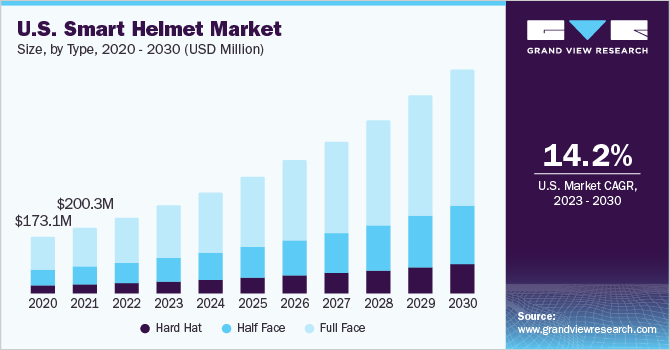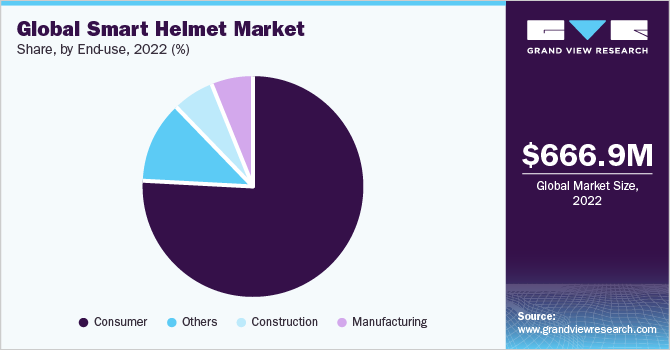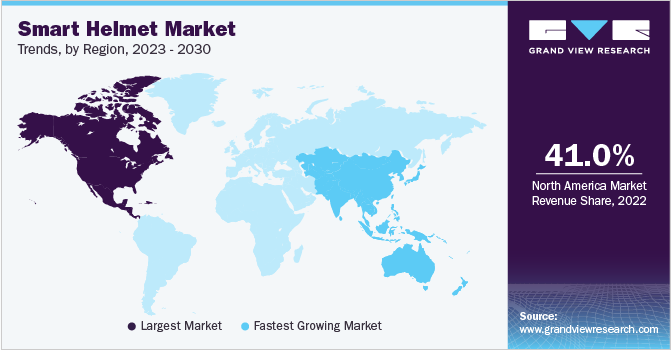- Home
- »
- Next Generation Technologies
- »
-
Smart Helmet Market Size And Share Analysis Report, 2030GVR Report cover
![Smart Helmet Market Size, Share & Trends Report]()
Smart Helmet Market Size, Share & Trends Analysis Report By Type (Full Face, Half Face, Hard Hat), By Component (Communication, Navigation, Camera), By End-use, By Region, And Segment Forecasts, 2023 - 2030
- Report ID: GVR-2-68038-953-1
- Number of Report Pages: 110
- Format: PDF, Horizon Databook
- Historical Range: 2017 - 2021
- Forecast Period: 2023 - 2030
- Industry: Technology
Smart Helmet Market Size & Trends
The global smart helmet market size was valued at USD 666.9 million in 2022 and is expected to grow at a compound annual growth rate (CAGR) of 17.0% from 2023 to 2030. The market growth can be attributed to rising safety and security concerns and technological advancements in smart wearables. Smart helmets include multiple electronic devices and sensors that can help users gather real-time data, reduce operational risks, and improve safety in the long run. Moreover, stringent road safety regulations laid down by governments across the globe are expected to drive market growth over the forecast period.

Smart helmets offer better safety to individuals while using automobiles or working at construction sites. Smart helmets of the new age incorporate many technologically advanced features such as GPS, map navigation, health monitoring (Skin temperature monitoring), sensor data collection, humidity check, air quality check, live streaming camera, and interconnected devices, among other features. Key market players are launching innovative solutions in the market with revolutionary features. For instance, in May 2022, Sena Technologies, Inc. announced the launch of OutForce, a full face motorcycle smart helmet. The helmet has features such as Bluetooth 5.0 connectivity, 4-way Bluetooth Intercom, smartphone app compatibility, and integrated speakers & microphones. Such product launches are harnessing innovation and growth in the market.
Additionally, smart helmet technology providers are investing aggressively in research & development activities to develop innovative products and expand their respective product portfolios. New product launches are particularly aimed at enhancing the efficiency of a smart helmet and providing a better customer experience. For instance, in November 2021, Huawei, a technology provider, announced the launch of the Helmetphone BH51M Neo, a smart helmet, in China. The smart helmet offered smart features such as voice commands and Bluetooth calling. It is powered by the company’s operating system: HarmonyOS, and is suitable for biking, skateboarding, roller skating, and electric bicycle. Such product launches are contributing to the market’s growth.
Road traffic accidents are a significant public safety issue and the primary cause of disability and deaths worldwide. As per the World Health Organization (WHO), around 1.2 million people die yearly due to traffic accidents, and many are wounded or disabled. Moreover, according to the National Highway Traffic Safety Administration (NHTSA), an agency of the U.S. federal government and part of the Department of Transportation, 5,579 motorcyclists died in 2020, and another 82,528 were injured. The most common causes of motorcycle accidents were speeding, distracted driving, alcohol, and drug impairment, and improper lane use. The rising number of road accidents is driving governments across the globe to mandate helmet usage, creating significant growth opportunities for the smart helmet industry.
As per the National Highway Traffic Safety Administration (NHTSA), the efficacy of motorcycle helmets in reducing fatal injuries for riders and passengers is reported to be 37% and 41%, respectively. Additionally, the employment of motorcycle helmets is estimated to have safeguarded over 25,000 lives since 2002. Nevertheless, the expansion of the smart helmet industry may face significant impediments such as the high cost of smart helmets, substantial investments required in product research and development, apprehensions regarding vision obstruction, and inadequate knowledge concerning the safety benefits of these helmets. In response to these challenges, manufacturers are emphasizing on enhancing consumer awareness about the functionalities of smart helmets through diverse digital media platforms.
COVID-19 Impact Analysis
The outbreak of the COVID-19 pandemic adversely affected the smart helmet industry, mainly due to the restrictions and lockdowns imposed by governments on numerous industries to prevent the spread of the virus. This scenario led to disruptions in the supply chain operations, which decreased the sales of smart helmets during lockdowns. Moreover, restrictions on the movement of people reduced the demand for smart helmets among bike riders. On the other hand, frontline workers used smart helmets for temperature monitoring in several countries. For instance, in June 2020, officials from the Kingdom of Saudi Arabia (KSA) started using smart helmets that automatically scan people’s body temperature via thermal radiation. Such features of smart helmets proved to be beneficial during the COVID-19 pandemic. Furthermore, the demand in the global smart helmet industry is poised to increase as the consumer, construction, and manufacturing industry recovers from the adversities of the pandemic.
Type Insights
Based on type, the global smart helmet industry has been further segmented into full-face, half face, and hard hat segments. The full-face segment dominated the market in 2022 and accounted for a revenue share of more than 58.0%. Numerous companies across the globe are focusing on developing full-face smart helmets with built-in Bluetooth communication systems. For instance, in June 2020, Sena Technologies, Inc, a technology provider for motorcycle communications, announced the launch of Outrush, a modular smart helmet equipped with a Bluetooth communication system. Outrush is a DOT-certified helmet and was the latest addition to the company's line of smart helmets. Such launches bode well for the growth of the segment.
The hard hat segment is also expected to witness significant growth over the forecast period owing to the increasing demand for hard hats in North America and Europe's manufacturing, mining, and construction industries. Occupational injuries in the construction sector are a global issue, and the sector witnesses frequent accidents. Smart hard hats are used in the manufacturing, construction, and mining industries to identify harmful gas leakages, track real-time locations, and analyze the health vitals of users. These helmets aim to ensure enhanced safety for workers operating in challenging environments, driving the segment's demand in the smart helmet industry.
Component Insights
Based on component, the global smart helmet industry has been further segmented into communication, navigation, camera, and others (audio systems, health monitoring, lighting, and safety features). The communication segment dominated the market in 2022 and accounted for a revenue share of more than 33.0%. Smart helmets are incorporated with the Integration Communication System (ICS), allowing the bike rider to control all the functions and applications via voice order. When users connect their phones to the smart helmet, they can perform several hands-free functions, such as making calls and finding directions through the helmet’s microphone, contributing to the segment’s growth.
The navigation segment is expected to emerge as the fastest-growing segment over the forecast period. Smart helmets offer navigation, positioning, and tracking features owing to the use of a Global Navigation Satellite System (GNSS). They are incorporated with Augmented Reality (AR) interface, which allows the bike rider to view the projected image, on the helmet visor, about the route and other important aspects while maintaining complete focus on the road. Such features make the driving experience easier for motorcyclists. Additionally, workers in industries such as mining are leveraging smart helmets with navigation systems that help them navigate harsh or remote environments. Such factors are contributing to the segment’s increasing growth.
End-use Insights
Based on end-use, the market has been segmented into consumer, manufacturing, construction, and others (healthcare, mining, disaster prevention). The consumer segment dominated the market in 2022 and accounted for a revenue share of more than 75.0%. It is also expected to retain its dominance over the forecast period owing to the growing safety concerns and increasing sales of two-wheelers. Smart helmets are widely used in various sports events and by bike riders across the globe. They offer multiple features, such as an accidental alert system, a built-in Bluetooth system, and a system for cell phone charging through solar power. These features are attracting the interest of consumers toward the adoption of smart helmet technology, which is driving the segment’s growth.

The manufacturing segment is expected to emerge as the fastest-growing segment over the forecast period. Smart helmets protect the wearer from various physical threats in the manufacturing environment. Workers in the manufacturing segment may face hazardous environmental conditions such as suffocation, gas poisoning, and gas explosions. Hence, air quality and hazardous event detection are essential in the manufacturing industry. Smart helmets have the potential to detect and provide real-time monitoring of harmful gases such as LPG, CH4, and CO, among others. It can also detect humidity and temperature. The growing health concerns due to exposure to harmful gases in the manufacturing industry are driving the demand for smart helmets in the segment.
Regional Insights
North America dominated the smart helmet industry in 2022 and accounted for a revenue share of more than 41.0%. The U.S. market is relatively mature, and consumers in the U.S. are early adopters of emerging technologies. Additionally, smart helmet providers are also focusing on developing and enhancing their product portfolios in this region. For instance, in May 2021, Sena Technologies, Inc., a communication technology provider, announced the launch of Outrush R, a smart modular helmet, in North America. The product is the updated version of Outrush modular helmet. Such product launches and the strong regional presence of key market players are contributing to the regional market’s growth.

Asia Pacific is expected to emerge as the fastest-growing regional market over the forecast period. The increasing sales of two-wheelers, rapid urbanization in developing economies such as China and India, and the growing manufacturing sector in the Asia Pacific region are expected to be the major growth drivers for smart helmets in this region. Moreover, the growing adoption of advanced wearable technology among construction workers is creating significant growth opportunities for the regional market.
Key Companies & Market Share Insights
Companies are focusing on enhancing the functionalities of helmets through product innovation, the development of integrated communication, and navigation solutions to meet customer expectations. Currently, emerging players in the smart helmet market are concentrating on integrating multiple next-generation technologies such as Head-Up Display (HUD), sensor integration, Augmented Reality (AR), and Internet of Things (IoT) to expand their product portfolio, customer base, and geographic presence.
Market players are launching innovative solutions to strengthen their market share. For instance, in February 2023, MapmyIndia, an Indian geospatial and digital mapping company, announced the launch of its Mapples Gadgets for cars and bikes. These gadgets include GPS trackers, dash cameras, and smart helmet kits. These smart helmet kits can be used with traditional helmets, offering visual LED and audio cues while driving. Such initiatives are harnessing the innovation and growth of the market. The key players operating in the smart helmet market include:
-
Beijing BaBaALi Technology Co.Ltd
-
Crosshelmet
-
Bell Helmets
-
Forcite Helmet Systems
-
Intelligent Cranium Helmets LLC (ICH)
-
JARVISH INC
-
LIVALL Tech Co., Ltd.
-
H&H Sports Protection USA, Inc. (TORC)
-
Sena Technologies, Inc.
-
Lumos Helmet US
Smart Helmet Market Report Scope
Report Attribute
Details
Market size value in 2023
USD 770.6 million
Revenue forecast in 2030
USD 2,314.6 million
Growth rate
CAGR of 17.0% from 2023 to 2030
Base year of estimation
2022
Historical data
2017 - 2021
Forecast period
2023 - 2030
Report updated
May 2023
Quantitative units
Revenue in USD million and CAGR from 2023 to 2030
Report coverage
Revenue forecast, company market share, competitive landscape, growth factors, and trends
Segments covered
Type, component, end-use, region
Regional scope
North America; Europe; Asia Pacific; Latin America; MEA
Country scope
U.S.; Canada; UK; Germany; France; Italy; China; India; Japan; South Korea; Australia; Brazil; Mexico; Kingdom of Saudi Arabia (KSA); UAE; South Africa
Key companies profiled
Beijing BaBaALi Technology Co.Ltd; Crosshelmet; Bell Helmets; Forcite Helmet Systems; Intelligent Cranium Helmets LLC (ICH); JARVISH INC; LIVALL Tech Co., Ltd.; H&H Sports Protection USA, Inc. (TORC); Sena Technologies, Inc.; Lumos Helmet US
Customization scope
Free report customization (equivalent to up to 8 analysts working days) with purchase. Addition or alteration to country, regional, and segment scope
Pricing and purchase options
Avail customized purchase options to meet your exact research needs. Explore purchase options
Global Smart Helmet Market Report Segmentation
This report forecasts revenue growth at global, regional, and country levels and provides an analysis of the latest industry trends in each of the sub-segments from 2017 to 2030. For this study, Grand View Research has segmented the global smart helmet market report based on type, component, end-use, and region:

-
Type Outlook (Revenue, USD Million, 2017 - 2030)
-
Full Face
-
Half Face
-
Hard Hat
-
-
Component Outlook (Revenue, USD Million, 2017 - 2030)
-
Communication
-
Navigation
-
Camera
-
Others (Audio Systems, Health Monitoring, Lighting, Safety Features)
-
-
End-Use Outlook (Revenue, USD Million, 2017 - 2030)
-
Consumer
-
Manufacturing
-
Construction
-
Others (Healthcare, Mining, Disaster Prevention)
-
-
Regional Outlook (Revenue, USD Million, 2017 - 2030)
-
North America
-
U.S.
-
Canada
-
-
Europe
-
UK
-
Germany
-
France
-
Italy
-
-
Asia Pacific
-
China
-
India
-
Japan
-
South Korea
-
Australia
-
-
Latin America
-
Brazil
-
Mexico
-
-
Middle East & Africa
-
Kingdom of Saudi Arabia (KSA)
-
UAE
-
South Africa
-
-
Frequently Asked Questions About This Report
b. The global smart helmet market size was estimated at USD 666.9 million in 2022 and is expected to reach USD 770.6 million in 2023.
b. The global smart helmet market is expected to grow at a compound annual growth rate of 17.0% from 2023 to 2030 to reach USD 2,314.6 million by 2030.
b. North America dominated the smart helmet market with a share of 41.8% in 2022. This is attributable to rising safety standards such as the United States Department of Labor - Occupational Safety and Health Administration standards.
b. Some key players operating in the smart helmet market include Beijing BaBaALi Technology Co.Ltd, Crosshelmet, Bell Helmets, Forcite Helmet Systems, Intelligent Cranium Helmets LLC (ICH), JARVISH INC, LIVALL Tech Co., Ltd., H&H Sports Protection USA, Inc. (TORC), Sena Technologies, Inc., and Lumos Helmet US.
b. The smart helmet market growth can be attributed to rising safety and security concerns and technological advancements in smart wearables. Smart helmets include multiple electronic devices and sensors that can help users gather real-time data, reduce operational risks, and improve safety in the long run.
Share this report with your colleague or friend.
![gvr icn]()
NEED A CUSTOM REPORT?
We can customize every report - free of charge - including purchasing stand-alone sections or country-level reports, as well as offer affordable discounts for start-ups & universities. Contact us now
![Certified Icon]()
We are GDPR and CCPA compliant! Your transaction & personal information is safe and secure. For more details, please read our privacy policy.
We are committed towards customer satisfaction, and quality service.
"The quality of research they have done for us has been excellent."





